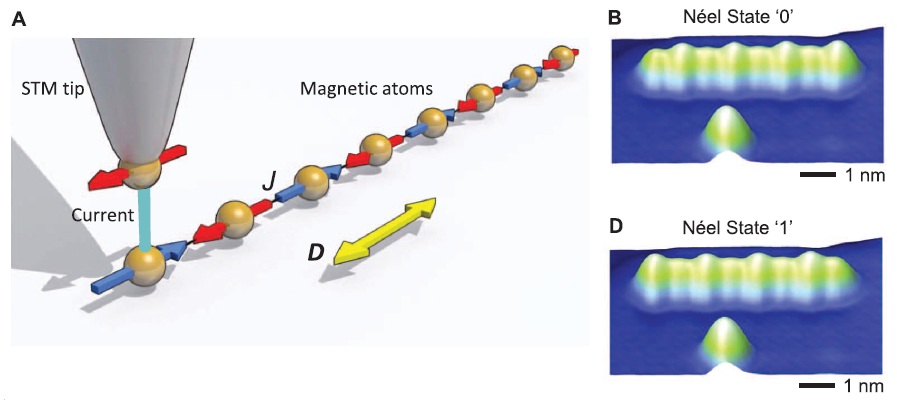
Information stored by a chain of magnetic atoms. Left: an STM tip measures the magnetic state of the iron atoms. Right: through increasing the current between tip and atoms the magnetic states can be switched. Peaks become valleys and vice versa. (c) Science Magazine
I now finally got the time to follow-up on last week’s paper in Science by Andreas Heinrich‘s group at IBM on magnetic storage elements that are only a few atoms in size. There have been a few misconceptions in some of the news reports with some being plainly wrong (‘smallest storage device ever made’), and many didn’t mention much about the scientific principles behind this study, although these are quite interesting. One of the better reports appeared in the New York Times, albeit again without going much into details. So I hope I can still add something useful with this blog post.
And actually, we’ve come across Andreas Heinrich’s previous research before, he does very innovative research with scanning tunneling microscopes (STM). In this latest Science paper he has now explored the limits of magnetic storage devices. Magnetism is of course the basis for storage such as magnetic hard drives. The problem in increasing the storage density in any magnetic storage device is that the magnetic regions begin to interfere with each other as they become smaller and are integrated closer together, because magnetic states on the order of just a couple of atoms are not very stable. […]
Continue reading...

The temporal cloak. A light beam of a single colour is directed at a split-time lens (STL) that converts it into different colours. As the beam then propagates through an optical fibre, the blue light components travel faster than the red ones (the vertical axis shows time), so that eventually a brief gap is formed in the travelling beam during which there is no light present. Therefore, any even taking place during that temporal gap will be concealed from the beam. Afterwards, a reverse process restores the original beam so that an observer does not notice the cloaking device. Reprinted by permission from Macmillan Publishers Ltd. Nature (2012). doi:10.1038/nature10695
Devices that conceal objects from an observer are called cloaks. Conceptually, the idea of cloaking devices has its roots in science fiction, but such devices have indeed been demonstrated in the past few years. These cloaks are based on tiny structures that are able to bend light on predetermined paths as it passes through the structure. This is like a lens, but consisting of manmade materials, and much more versatile and powerful.
A very different type of cloak has now been published in Nature by Alexander Gaeta and colleagues from Cornell University. Following earlier theoretical proposals, they have now demonstrated the first temporal cloak where events are hidden in time, not in space so that an event is concealed from a light beam travelling through the same space for a certain amount of time. To understand the difference of a temporal to a spatial cloak, Robert Boyd and Zhimin Shi from the University of Rochester make a very good comparison in their News and Views article on the paper: […]
Continue reading...




January 15, 2012
3 Comments